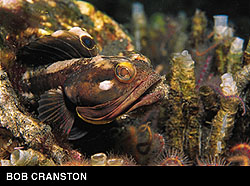![]()
 |
No one seems to remember how the sarcastic fringehead got its name, but it probably comes from its facial expression. It appears to view the world with a derisive sneer, as if everything were beneath its notice. But that's not how it behaves. It is perhaps the most ferocious fish along the Pacific coast of the United States. Fortunately, it only reaches a maximum length of about twelve inches; much larger and no one would want to go near the water.
Up close, this tiny, pugnacious fish appears all head, mouth, and needle-like teeth. If "The Muppet Show" ever needs a demon to populate some miniature puppet underworld, the sarcastic fringehead would be a perfect model. Its most outstanding characteristic is its enormous mouth, larger in males, that extends the full length of the head to the edge of the gill cover.
Many a diver can attest to the sharpness and tenacity of its bite, and a fisherman who snares one by accident (there's nothing there to eat), discovers he has a mini-monster in his net.
The sarcastic fringehead (Neoclinus blanchardi) is found in nearshore waters from about ten to 250 feet deep, from San Francisco to central Baja California. It inhabits small abandoned burrows and shells, crevices among rocks, and is particularly fond of discarded cans and bottles. The fringehead rarely leaves its home and defends it fiercely, attacking anything that comes near, regardless of the intruder's size.
When defending its home, whether a crack in the rocks or a beer can condominium, a fringehead can open its mouth so wide that its head all but disappears. Adults are almost completely fearless and very ill-tempered. Anything that approaches their territory can trigger animated threat displays, complete with flexing jaws, spreading of gill covers, and snapping of teeth. The display culminates in vicious, gaping-mouth attacks on the intruder.
Spawning occurs January through August with females laying eggs, which are aggressively protected by the males until they hatch. Despite their ferocity, males have a tender side. They are devoted fathers, and will often collect and brood the eggs in their mouths to provide maximum protection. If they happen to be threatened while carrying a mouthful of eggs, the males disgorge them into their hidey-hole so that they can bring their full weaponry to bear until danger passes.
Their body coloration is commonly mottled dark brown or gray, although males are occasionally black. On their dorsal fin are two beautiful bright blue spots surrounded by yellow. The rear section of the male jaw is also a vibrant yellow. Both males and females have several thin, branched flaps of skin (cirri) above the eyes and on the head. They add to that sarcastic demeanor.
Dale Stokes is a researcher at Hopkins Marine Station in Pacific Grove, California.
![]()